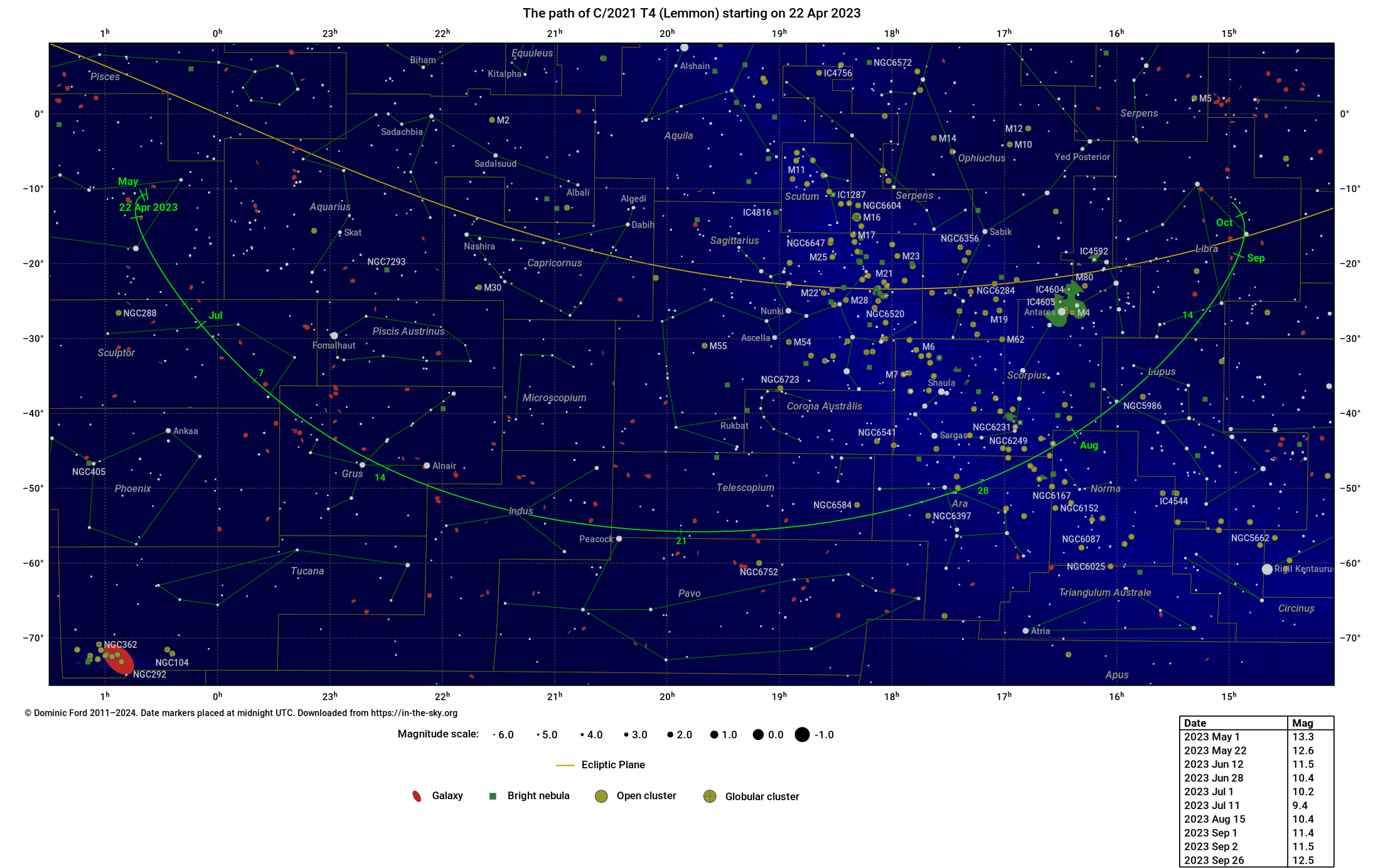Comet C/2021 T4 (Lemmon) is forecast to reach the brightest point in its 2023 apparition on 20 July. At that time, it will lie at a distance of 1.49 AU from the Sun, and at a distance of 0.54 AU from the Earth.
From South El Monte on 20 July it will not be readily observable since it will lie so far south that it will never rise more than 0° above the horizon.
The events that comprise the 2023 apparition of C/2021 T4 (Lemmon) are as follows:
| Date | Event |
| 20 Jul 2023 | Comet C/2021 T4 (Lemmon) passes perigee |
| 20 Jul 2023 | Comet C/2021 T4 (Lemmon) reaches peak brightness |
| 31 Jul 2023 | Comet C/2021 T4 (Lemmon) passes perihelion |
The table below lists the times when C/2021 T4 (Lemmon) will be visible from South El Monte day-by-day through its apparition:
| Date | Constellation | Comet visibility |
| 29 Jun 2023 | Sculptor | Not observable |
| 01 Jul 2023 | Sculptor | Not observable |
| 03 Jul 2023 | Sculptor | Not observable |
| 05 Jul 2023 | Sculptor | Not observable |
| 07 Jul 2023 | Sculptor | Not observable |
| 09 Jul 2023 | Grus | Not observable |
| 11 Jul 2023 | Grus | Not observable |
| 13 Jul 2023 | Grus | Not observable |
| 15 Jul 2023 | Indus | Not observable |
| 17 Jul 2023 | Indus | Not observable |
| 19 Jul 2023 | Telescopium | Not observable |
| 21 Jul 2023 | Telescopium | Not observable |
| 23 Jul 2023 | Telescopium | Not observable |
| 25 Jul 2023 | Ara | Not observable |
| 27 Jul 2023 | Ara | Not observable |
| 29 Jul 2023 | Ara | Not observable |
| 31 Jul 2023 | Norma | Not observable |
| 02 Aug 2023 | Lupus | Not observable |
| 04 Aug 2023 | Lupus | Not observable |
| 06 Aug 2023 | Lupus | Not observable |
| 08 Aug 2023 | Lupus | Not observable |
A more detailed table of C/2021 T4 (Lemmon)'s position on each night is available here. A diagram of the orbit of C/2021 T4 (Lemmon) is available here.
Finder chart
The chart below shows the path of C/2021 T4 (Lemmon) over the course of its apparition, as calculated from the orbital elements published by the Minor Planet Center (MPC). It is available for download, either on dark background, in PNG, PDF or SVG formats, or on a light background, in PNG, PDF or SVG formats. It was produced using StarCharter.
Comet brightnesses
Comets are intrinsically highly unpredictable objects, since their brightness depends on the scattering of sunlight from dust particles in the comet's coma and tail. This dust is continually streaming away from the comet's nucleus, and its density at any particular time is governed by the rate of sublimation of the ice in the comet's nucleus, as it is heated by the Sun's rays. It also depends on the amount of dust that is mixed in with that ice. This is very difficult to predict in advance, and can be highly variable even between successive apparitions of the same comet.
In consequence, while the future positions of comets are usually known with a high degree of confidence, their future brightnesses are not. For most comets, we do not publish any magnitude estimates at all. For the few comets where we do make estimates, we generally prefer the BAA's magnitude parameters to those published by the Minor Planet Center, since they are typically updated more often.
No estimate for the brightness of comet C/2021 T4 (Lemmon) is currently available.
The comet's position on 20 July 2023 will be:
| Object | Right Ascension | Declination | Constellation | Magnitude |
| Comet C/2021 T4 (Lemmon) | 19h59m30s | 55°56'S | Telescopium | 9.0 |
The coordinates are given in J2000.0.
The sky on 20 Jul 2023
| The sky on 20 July 2023 | ||||||||||||||||||||||||||||||||||
|
11% 3 days old |
All times shown in PDT.
|
|||||||||||||||||||||||||||||||||
Source
This event was automatically generated on the basis of orbital elements published by the Minor Planet Center (MPC) , and is updated whenever new elements become available. It was last updated on 15 Dec 2025.
Image credit
© Andy Roberts 1997. Pictured comet is C/1995 O1 Hale-Bopp.



